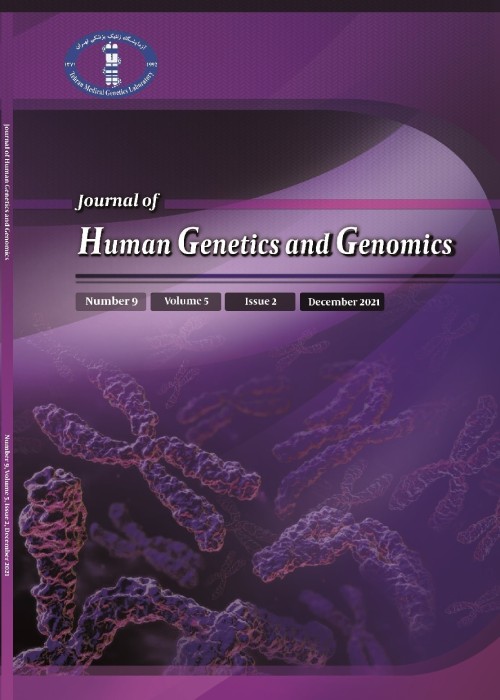فهرست مطالب
Journal of Human Genetics and Genomics
Volume:2 Issue: 1, Jul 2018
- تاریخ انتشار: 1398/05/15
- تعداد عناوین: 6
-
-
Page 1
Multiple sclerosis (MS) is a chronic inflammatory demyelinating disease of the central nervous system (CNS). Currently a single accurate method for diagnosis of MS is lacking. Exosomes are small membranous transport vesicles providing a means of cell-to-cell communication by transporting their cargo. Considering accumulating evidence emphasizing potential role of exosomes in the regulation of the immune system, circulating exosomes represent promising candidate biomarkers multiple sclerosis.
Keywords: Multiple Sclerosis, microRNAs, Exosome -
Page 2
Congenital enterokinase deficiency is a rare autosomal recessive disorder of gastrointestinal tract in newborns. Enterokinase initiates digestion of protein by conversion of trypsinogen into trypsin. We analyzed the parents of unaffected deceased newborn with congenital enterokinase deficiency by exome sequencing. The results of exome sequencing identified a novel heterozygous frameshift deletion, c.151-155del p.Ala51Trpfs*5, in TMPRSS15 gene. Direct sequencing confirmed that the couple had heterozygous status. TMPRSS15 gene mutations are completely rare. To date, one small deletion and three nonsense mutations are reported in this gene in Human Gene Mutation Database (HGMD®). The identified mutation leads to complete absence of enzymatic activity.
Keywords: Congenital Enterokinase Deficiency, TMPRSS15, Frameshift Mutation -
Page 3Background
The type II form of neurofibromatosis (NF2) is an autosomal dominant multiple neoplasia syndrome characterized by tumors of the eighth cranial nerve (usually bilateral), meningiomas of the brain, and schwannomas of the dorsal roots of the spinal cord. The incidence of neurofibromatosistype II is 1 in 25,000 live births.
MethodsTo further understand the genetic spectrum of NF2, we analyzed an individual affected with multifocal schwanomatosis by whole exome sequencing. Potential candidate mutations were checked in additional family members to determine if the putative mutation segregated with disease status.
ResultsNo pathogenic variant was identified in NF1 and NF2 genes however, a novel nonsense homozygous mutation p.Q675X in PMS1 gene was identified. Direct sequencing confirmed that the patient is homozygous and her parents are heterozygous for the identified variant.
ConclusionsTo the best of our knowledge it is the first report of involvement of PMS1 mutations in NF2. However, genetic testing of NF1 and NF2 genes in affected tissues to rule out somatic mutations as well as functional study for the identified variant are required to clarify under what circumstances mutations of this gene cause tumorigenesis.
Keywords: PMS1, Neurofibromatosis Type 2, Schwanomatosis -
Page 4
Nesfatin-1 (NUCB2) gene, was introduced as a novel satiety factor involves in the control of energy homeostasis in the hypothalamus. Since NUCB2/nesfatin-1 has an effect on diabetes and obesity, it is a candidate gene that can be responsible for causing coronary artery disease (CAD).Therefore, we aimed to identify the association between rs214101 (C/T) SNP of NUCB2 gene and the possible amplified effects of this genetic variation together on the development risk of CAD in this study.This study was carried out in 110 patients with CAD, and 69 CAD-free controls. The NUCB2/nesfatin-1 rs214101 genotypes were analysed by PCR-RFLP technique. The CC genotype frequency of the NUCB2 rs214101 was greater in control group than CAD group (34.8% vs.52.7%; P = 0,019).The CC-genotype was associated with low serum HDL-C level compared to T allele in female CAD subgroup (P = 0.031), but, not in males. Unlike the CAD group, it was observed that the male control subjects carrying CC genotype have higher serum HDL-cholesterol and diastolic blood pressure levels than those with T allele (P = 0.043 and P = 0.031, respectively) but, not in females. Logistic regression analysis confirmed that the NUCB2/Nesfatin-1 rs214101 CC-genotype is associated with low serum HDL-cholesterol in female CAD patients. Our results suggest that the CC genotype of NUCB2 rs214101 may contribute to susceptibility CAD risk in relation to low HDL-C and that the genetic effect could differ by gender.
Keywords: Obesity, Gene, Atherosclerosis, Diabetes, NUCB2, Nesfatin-1 -
Page 5
The capability of cancer cells including tumor initiation, maintenance, and extension is associated with cancer stem cells. The substantial features of CSCs are self - renewal and pluripotency. Therapeutic resistance of CSCs can result in cancer recurrence and failure of cancer treatment. Isolation and characterization of CSCs are required for targeted cancer therapies. CSCs can be distinguished and separated by surface markers. In this review, after definition of CSC hypothesis, different markers of CSC are introduced. The information about CSC markers provides promise for better isolation and more effective CSC-targeting therapeutic in future.
Keywords: Cancer, Markers, Stem Cells -
Page 6
Hemophilia is a coagulation disorder in which bleeding time is prolonged. There are a number of hemophilia subtypes and more than 4,000,000 individuals are suffered worldwide. The most common types of hemophilia are type A and B in which coagulation factor VIII and IX are defected respectively. Type A hemophilia is responsible for 80% to 85% of cases. The genes of 8 and 9 coagulation factors located on the long arm of X chromosome and mutation in these genes causes disturbance in coagulation. This disease is a very good target for gene therapy because if amount of protein production reaches 1% that of normal the disease phenotype is modified. Different methods of hemophilia gene therapy include increased production of coagulation factors via insertion of attributed genes into patient’s stem cells by vectors, or insertion of transgenes into differentiated cells with prolonged survival such as muscle or liver cells. One of the most recent advances in hemophilia gene therapy is using induced pluripotent stem cells (iPS) for gene transfer. Hepatocytes are very good candidates for hemophilia gene therapy due to their natural capacity for production of coagulation factors. Myocytes are also suitable for injection of transgene because they are available and have sufficient secretory power. Most important and useful viral vectors for hemophilia are retroviral, lentiviral, and Adeno- Associated viruses. Among these only the retroviral vectors target dividing cells.
Keywords: Gene Therapy, Hemophilia, iPS


